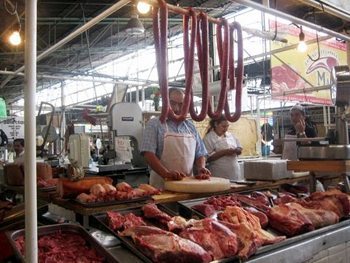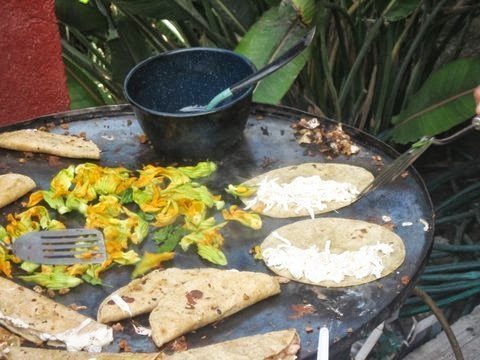
Gluten-Free and Muslim Eating In Mexico, try to avoid Pork
By Stephanie Meade

Perhaps a bit naïve, I wasn’t too worried about being non-pork eaters and also gluten-free before our trip to Mexico.
There are plenty of non-pork and corn-based options I figured—corn tortillas are a staple after all.
To start, I’m not Muslim but my family is so I don’t eat pork either. Plus, I’ve never been a fan of pork anyway. I am also not strictly gluten-free but my daughter and husband are, which means as a family, we eat gluten-free.
Finding Halal Food in Mexico
As far as how strict we are in terms of following a Muslim diet, while we definitely don’t eat pork, we don’t always eat halal at home (halal meaning “permissible” or “lawful” specifies foods (as well as other actions beyond food) that Muslims are allowed to eat under Islamic law.
The criteria include both what foods are allowed, and how the food must be prepared, which is very similar to eating kosher. In fact, it is so similar, Muslims can eat kosher when no halal is available. It doesn’t work in reverse though).
Looking for halal options, or avoiding non-halal meat, would have been pretty tough in many parts of Mexico. Now that we got the basics out of the way, here’s how we managed.

We started our trip in the colonial town of Puebla, a world heritage site, which was a challenge for our family of non-pork eaters.
Layering gluten-free onto that was like playing a game of Twister. Everywhere we went—from high-end restaurants like Mi Ciudad in Puebla to street vendors, it was an obstacle course avoiding pork.
At first, the options always looked promising. In every restaurant or even street vendors, there were a variety of straight-laced beef and chicken options. But all these beef and chicken dishes—fajitas, chalupas, tacos, mole, and more—had a secret.
Most usually contained some sort of disguised pork part.

Those black beans on the side? Not so hidden pork chunks surrounding a calzone-type food.
Those refried beans? Cooked with a pork hock. Those chicken chalupas, which had no pork I confirmed several times?
Turned out they were cooked in Manteca, pork fat. That special mole sauce that every Mexican from as far as the U.S. told us to try in Puebla, as Puebla has the best mole in ALL of Mexico? Yep, hidden Manteca again.
I learned to ask if whatever we were ordering was cooked in Manteca because 80% of the time (that may be an understatement) it was and no one thought about Manteca as pork. (And it wasn’t due to their not understanding my Spanish either since I’m fluent.)

I also realized it was helpful to tell people it was for “religious reasons” that we didn’t eat pork (no one ever asked which religion), as that seemed to garner more gravity about our food preferences than if I just asked about pork in the three different pedantic ways I inquired: Is there any pork in this? No pork. What about bacon or Manteca?
Nope, there isn’t. Are you sure that nothing in the dish has any pork? Yes, no pork. It’s for religious reasons we can’t eat it. Well, I don’t think so, but let me be sure. I’ll ask the cook.
Many times, despite the number of times I had specified the no pork thing, the dish would invariably arrive with pieces of pork waving a sinister hello to us on the plate. It began to feel like a losing battle, but people were always very kind about changing it.
Gluten-Free foods in Mexico
An easy alternative to the pork bounty would have been to stick with bakeries, pasta, and pizzerias, which were everywhere.
But with my daughter and husband gluten-free, those were out too, making things extra dicey. Just to make sure I was the most annoying tourist that waiters had ever had the displeasure of serving, every time we ordered, after verifying there was no pork in the meal (in the three different ways), I then had to confirm that whatever I was ordering was free of gluten (in two different ways).
I made sure to tell the server my daughter was allergic to harina de trigo (wheat flour). I also inquired if a portion of food was empanado (breaded) because most people didn’t think of breaded chicken or breaded anything as having wheat in it. Sometimes, ostensibly corn tortillas could be mixed with wheat flour but only occasionally.
One of the best food options for using Puebla wassopa de pollo (chicken soup), simple broth, chicken and a veggie or two. If it wasn’t on the menu, they could make it without any fuss.
One of the secrets about going out to eat in Mexico is they’ll readily cook you stuff that’s not on the menu. Just ask! Additionally, rotisserie or grilled chicken, corn tortillas and rice, accompanied by a slightly spicy, red chile sauce and green tomatillo sauce—thanks to the chain El Pollo Loco and its many clones—were as commonplace as fast food in the U.S. (That doesn’t mean Puebla was KFC-free by any means though, unfortunately!)

Freshly made tortilla chips and guacamole were another trip staple that turned into an over-indulgence. Please don’t show me either one of those for a long time.
Another safe food for us was fruit, so much good fruit, especially my favorite: mango!

You could layer on a variety of dried toppings from the savory—different kinds of chile—to the sweet—watermelon and strawberry sugar.
My favorite was sweet, juicy mango with lime and chile, especially Tampico, a not so spicy sprinkle of chile. Jicama was just as good with lemon and Tampico.
Our next stop was Akumal, just north of Tulum. Along the Mayan Riviera, eating gluten and pork-free was a breeze as fish was everywhere. Each night we had some fish variation—fresh fish in butter and garlic, ceviche, shrimp kebab, mixed fish on the grill.
Most of the coastal restaurants didn’t have the same tendency toward hidden pork or Manteca, so we could also eat beans again. Black beans with tortilla chips became the go-to meal for my picky four-year-old.
All in all, it wasn’t unmanageable eating gluten-free as Muslims in Mexico. Next time though, I may warp into one of those travelers I have never really understood that bring food from home (gasp!) and stash some gluten-free granola bars for my daughter just in case!

Stephanie Meade is the Founder and Editor-in-Chief of InCultureParent.com, a magazine for parents raising little global citizens. She has lived and worked in many countries worldwide and currently calls Berkeley, California home, but is never sure for how long she’ll stay in one place. Her articles have been published in Rosetta Stone, InCultureParent.com and on Huffington Post.
- These 9 U.S. National Parks Require Reservations in 2024 - April 17, 2024
- Take a Hike in Olympic National Park - April 17, 2024
- The Wild Mississippi: 2340 Miles Across Ten States - April 8, 2024






I know exactly how you feel. There is pork and lard anywhere. And there is a disconnect between the waiter and the cook. Many times the waiter (or better yet as you titled him/her- “server”, as many are just servers, bringing from kitchen to table) – has little or no much knowledge about any dish.
And many times even the cook (can’t call them Chefs) wouldn’t even know, as many times them refried beans come out this way straight from the can, and the cook is just heating it up; And lard is part of them ingredients.
So you opt for rotisserie chicken instead; are you sure they did not smear that bird with ample amount of lard prior to turning in the grill? They use shortening mixed with lard as their people like this taste.
Now about “replacing the dish with another, just ask”…. Yes they will replace but they will charge you extra or double for it. The term “substitute” (one for another) does not appear in any Mexican restaurant when it comes for a fixed price menu.
(And how I miss the American service)
In the end you found safety in tortilla chips and guacamole, and in fruits. Now, that is a real Mexican food superb experience, I am impressed. Fruits and tortillas…. Real Mexican cuisine delights you can live on for a 2-week vacation.
Then we go beck to America, God bless America.
I lived as a Muslim for more than 14 years and now I keep an even more strict Eco-Kosher pesco-vegan diet (about 95% vegan aside from occasional kosher fish). You are 100% correct. I lived in Los Angeles for six years and learned to stay away from most Mexican restaurants because most of them cook with pork constantly. I’m Peruvian. We cook in vegetable oil and olive oil. Unless a dish specifically has pork meat in it, (and Peruvians generally don’t eat a lot of pork anyway) it’s pork free. There were one or two food truck vendors in L.A. from whom I’d get food because I knew that they didn’t cook the stuff with any lard and always served me the beans that were cooked in water. I also noticed that a disproportionate number of Mexicans in Los Angeles (more than 50% of Angelinos are Mexicans or Mexican – Americans) are grossly overweight, many of them having fat children that look like little walking sundaes with chubby – cheeked/double – chinned heads, sloppy arms and legs sticking out. It’s sad because they’re usually such nice people (aside from the fact that many enjoy butchering baby animals – lechones – and think that taking their 4 and 5 year olds to bullfights does not constitute traumatic child abuse).